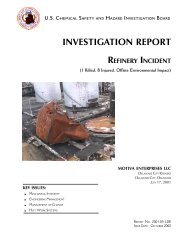CTA Report, Draft 1, ISP Review - US Chemical Safety and Hazard ...
CTA Report, Draft 1, ISP Review - US Chemical Safety and Hazard ...
CTA Report, Draft 1, ISP Review - US Chemical Safety and Hazard ...
You also want an ePaper? Increase the reach of your titles
YUMPU automatically turns print PDFs into web optimized ePapers that Google loves.
have escaped through an open oven door (Section 5.1.2), or the dust cloud may have entered the oven <strong>and</strong><br />
ignited.<br />
7.1.1.3 Other Possible Ignition Sources<br />
CSB considered other potential sources of ignition at the point of origin, as noted below, but concluded<br />
that they were unlikely:<br />
• Electrical equipment: Several electrical boxes containing switches <strong>and</strong> relays were located<br />
in the area of origin <strong>and</strong> might have produced electrical sparks. The boxes were not dust-<br />
tight, <strong>and</strong> such sparks would have been capable of igniting a combustible dust cloud. CSB<br />
contractors examined the electrical boxes <strong>and</strong> concluded that—though they were fire-<br />
damaged—there were no indications that the spark-producing electrical equipment inside<br />
provided an ignition source (Appendix C).<br />
• Lube oil system: The lube oil system <strong>and</strong> pump for the oven flights were also examined. The<br />
piping for the high-temperature oil had no moving parts <strong>and</strong> was found to be free of leaks.<br />
The oil pump was pneumatically operated.<br />
• Static electricity: CSB also eliminated static electricity as an ignition source. Interviews<br />
with line crews revealed that electrostatic discharges occurred frequently when the mat-<br />
former was cleaned of phenolic resin. However, no one interviewed could recall an instance<br />
when the phenolic resin ignited. Tests conducted by a CSB contractor confirmed that the<br />
static energy in a propagating brush discharge 17 (PBD) was incapable of igniting the resin<br />
because it did not produce enough energy (Appendix B).<br />
17 PBDs are lightning-like electrostatic discharges. They are the most energetic of all types of electrostatic<br />
discharges, with spark energies approaching 1 joule.<br />
54









